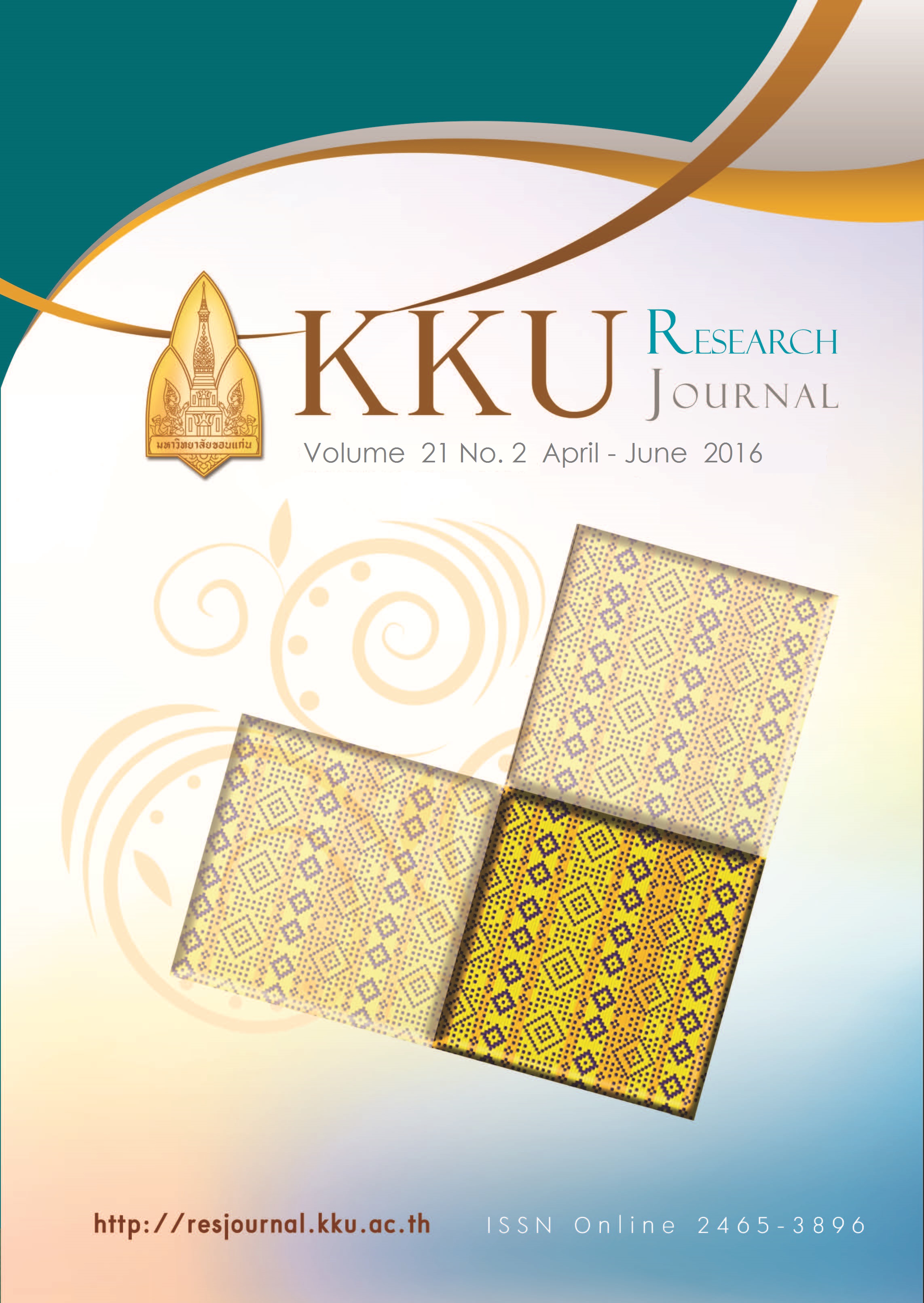Polyhydroxyalkanoate (PHA) synthesis by newly bacterial isolates using non-detoxified rice husk hydrolysate
Main Article Content
Abstract
Rice husk, a low cost carbon sources from agricultural waste was used for PHAs production. However, the structural complexity of lignocellulosic materials in rice husk requires a pretreatment step prior used as carbon source. The effect of the main operating factors including sulfuric acid concentration and hydrolysis temperature on fermentable sugar production from rice husk were investigated by response surface methodology. The results indicated that total sugar and reducing sugar concentration ranged between 12.36 and 30.12 g/L, and 0.28 and 6.66 g/L, respectively. The satisfactory condition of 9.20 % w/v sulfuric acid at 107.86 0C was established for reducing sugar and total sugar productions. Furthermore, the non-detoxified rice husk hydrolysate was then used as a carbon source for 10 isolate microbial strains to test PHA production capability. It was found that the highest biomass was observed as 1.01g/l and PHA content as 11.2 %.
Article Details
References
[2] Dagnino EP, Chamorro ER, Romano S D, Felissia FE, Area MC. O p t i m i z a t i o n o f t h e a c i d pretreatment of rice hulls to obtain fermentable sugars for bioethanol production. Industrial Crops and Products, 2013; 42(0): 363-368.
[3] Rambo MKD, Bevilaqua DB, Brenner C GB, Martins AF, Mario DN, Alves SH, et al. Xylitol from rice husks by acid hydrolysis and Candida yeast fermentation. Quimica Nova, 2013; 36: 634-639.
[4] P a t e l S S . P r o d u c t i o n o f Polyhydroxybutyrate using agroindustrial waste by Psuedomonas aeruginosa. International Journal of Innovation and Applied Studies,2014; 3(2): 107-110.
[5] G o w d a V, S h i v a k u m a r S . Agrowaste-based Polyhydroxyalkanoate (PHA) production using hydrolytic potential of Bacillus thuringiensis IAM 12077. Brazilian Archives of Biology and Technology, 2014; 57: 55-61.
[6] Jumlongsong P, Soemphol W. Isolation and characterization of polyhydroxyalkanoates (PHAs) producing microorganism using xylose as carbon source. Special project, Faculty of Applied science and Engineering, Khon Kaen
University, Nonkhai Campus. 2014.
[7] Tanamool V, Imai T, Danvirutai P, Kaewkannetra P. An alternative approach to the fermentation of sweet sorghum juice into biopolymer of polyhydroxyalkanoates (PHAs) by newly isolated, Bacillus aryabhattai PKV01. Biotechnology
and Bioprocess Engineering, 2013;
18(1): 65-74.
[8] Breuil C, Saddler JN. Comparison of the 3,5-dinitrosalicylic acid and Nelson-Somogyi methods of assaying for reducing sugars and determining cellulase activity. Enzyme and Microbial Technology.1985; 7(7): 327-332.
[9] DuBois M, Gilles KA, Hamilton JK,Rebers PA, Smith F. Colorimetric Method for Determination of Sugars and Related Substances. Analytical Chemistry, 1956; 28(3):350-356.
[10] Law JH, Slepeky RA. Assay of poly-beta-hydroxybutyric acid. Journal Bacteriology, 1961; 82:33–36.
[11] Bensah, EC, Mensah M. Chemical Pretreatment Methods for the Production of Cellulosic Ethanol: Technologies and Innovations. International Journal of Chemical Engineering, 2013; 21.
[12] El-Tayeb TS., Abdelhafez AA., Ali S.H., Ramadan E.M. Effect of acid hydrolysis and fungal biotreatment on agro-industrial wastes for obtainment of free sugars for bioethanol production. Brazilian Journal of Microbiology, 2012;43(4): 1523-1535.


